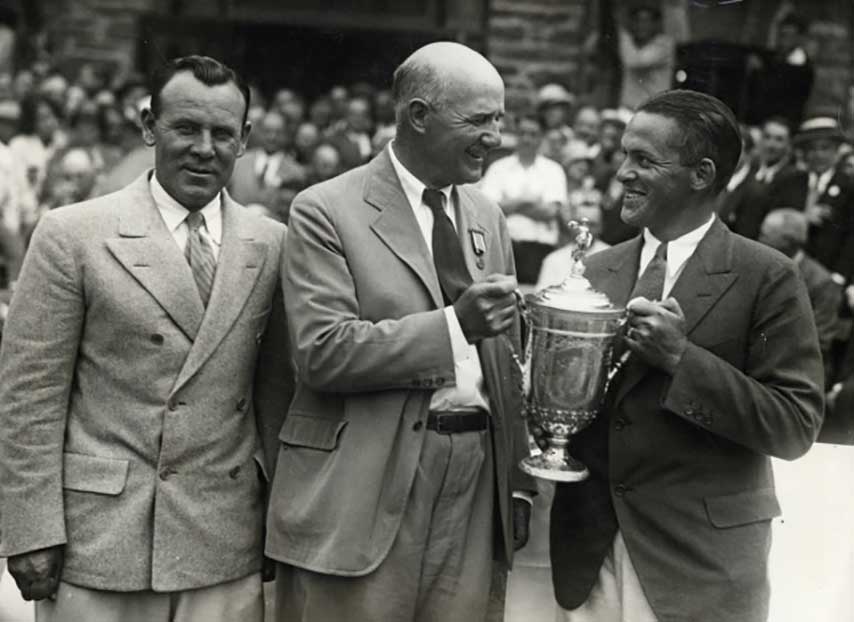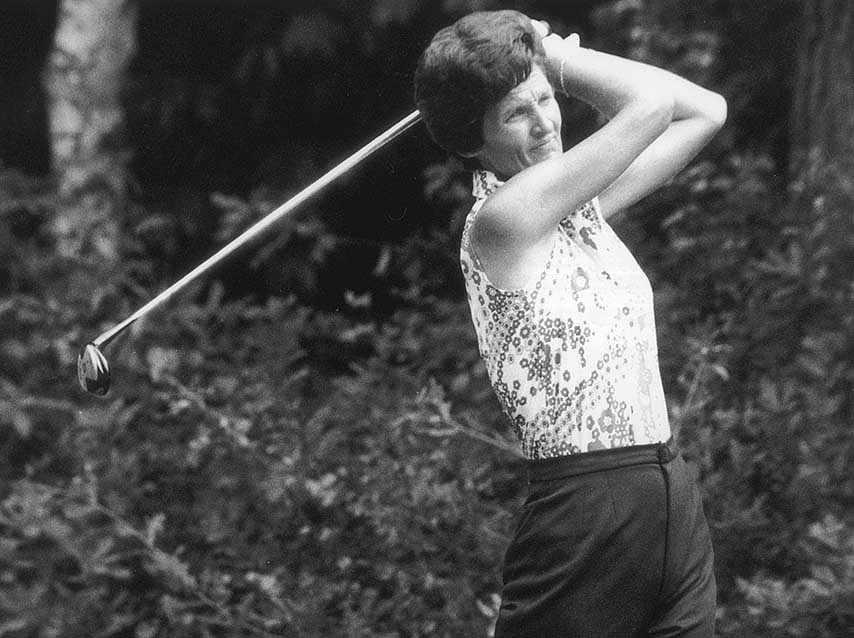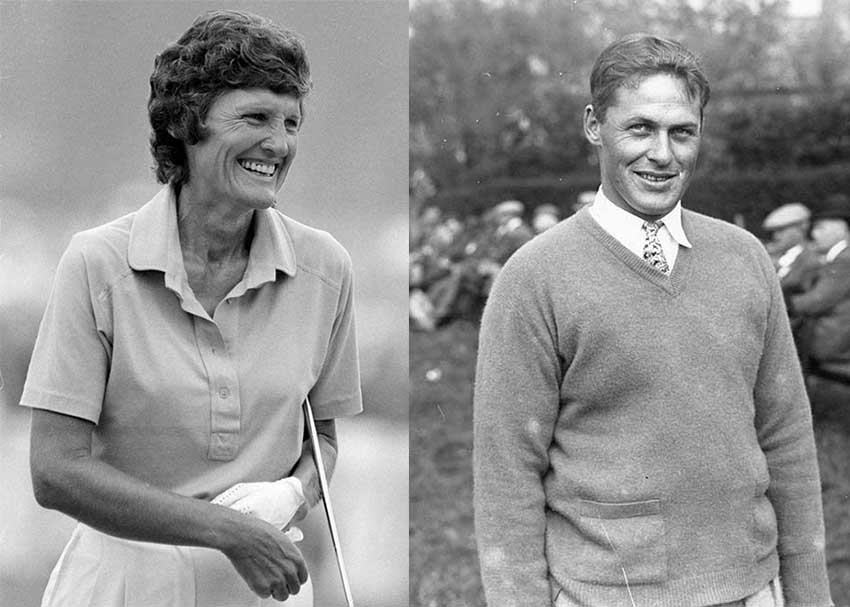With seven and six Grand Slam titles, respectively, American Bobby Jones and Kathy Whitworth are sixth and seventh in the rankings of major championship winners.
Jones is considered by many as the best golfer in the history of the game. This might be considered arguable considering the many great players over the years, but he is, without doubt, the one who recorded most successes in such a limited time. This was because Bobby Jones only played at the top level during three months of the year, travelling to the major tournaments in summer.
No-one would have expected much of the ill child born in Atlanta in 1902, who until the age of five years was unable to eat solid food. The son of a lawyer in Atlanta, Robert Tyre Jones had the good fortune, when he was six, of his family moving home close to East Lake Country Club, where the young Bobby began playing sports, mostly baseball and golf, finally developing physically in good conditions.
His natural talent for golf was obvious from the start, and proof of that is that he never received classes – learning how to swing by watching how the pros played at the club. Jones developed a natural and fluid swing which became his trademark of the time.
Encouraged by his father, Bobby began to play competitive golf and, at just six years, he won his first tournament, against three children in East Lake. At nine, he won the Atlantic Athletic Club junior title, beating a 16-year-old rival. After various more titles, he became the youngest player, at 14, to qualify for and play in the US Amateur Championship. Even though he didn’t win, he was a sensation.

The future seemed promising for the young Jones but the winning run didn’t continue as expected. The problem was obviously his youth, his still-to-be-formed character, and the pressure of so much expectation. Jones was a perfectionist in his play and was under so much self-inflicted pressure that in some tournaments he lost several kilograms due to the stress. He also had a bad temper on the course and it wasn’t rare to see him throw his clubs with anger. This ill temper reached a crucial moment in 1921 during the British Open when he abandoned the course in the middle of the round. He was just 19.
Jones lived two distinct eras in his sporting career. The first was from 14 to 21 years; and the second, from 21 to 28. The latter was, without doubt, his finest – when he won his Grand Slam titles.
In the 1923 US Open, the long-awaited victory finally arrived, in his 10th Grand Slam appearance. Bobby entered the final day with a three-stroke lead, but he lost that at the end of the round with two bogeys and a double-bogey. After coming off the 18th green, he said, “I haven’t finished like a champion, but like a yellow dog.” When Bobby Cruickshank secured a birdie on the last hole, the tournament went to an 18-hole play-off the next day. Arriving at the last hole level, Jones hit a 180-metre two-iron second shot to two metres from the flag – for his first win in a major.
His magnificent run had begun. From 1923 to 1930, Jones played in 21 Grand Slam championships and won no fewer than 13 of them. It should be noted that, in that era, the US Amateur and the British Amateur (both won by Jones) were considered majors, although in the current lists of Grand Slam winners they are not counted as they are no longer recognised as majors. His brilliant record ended in 1930 with a complete Grand Slam, which at the time comprised the US Open, US Amateur, British Open and British Amateur. He won the US Open in 1923, 1926, 1929, and 1930; the British Open in 1926, 1927 and 1930; the US Amateur in 1924, 1925, 1927,1928 and 1930; and the British Amateur in 1930.
Just one month later, aged 28 and at the peak of his career, he retired from top-level golf and dedicated himself to other golf-related occupations. Jones was unlike any other player at his level, as he only played 80 rounds a year, travelling and competing for just three months. Having contributed so much as a player, he wanted to demonstrate his genius in other golfing areas. He was a pioneer of golf teaching films (“How to play golf”), in a project commissioned by Warner Brothers.
He was also an adviser to the Spalding company in the design of golf clubs; as a player he had always worked closely with manufacturers to design his own clubs. After rejecting more than 200 different clubs, Jones finally approved a set that satisfied him. The clubs had an iron shaft, a design which rapidly replaced the wood shafts used by Jones. Each club was designated a number instead of the old Scottish names used until then. This innovation became an industry standard which still applies today.
Nevertheless, his most renowned and well-known legacy is, without doubt, Augusta National, birthplace and home of the US Masters, and arguably the best golf course in the world.
In 1942, at 40, he was a US army captain during World War II, taking part in the Normandy landing. In 1948, he suffered his toughest setback: diagnosed with a rare disease of the nervous system, he was never able to play golf again. He suffered severe back and neck pain, and medical tests showed he had growing osseous in three cervical vertebras. At first he had to use a cane when walking, later crutches, and during the final years of his life he was confined to a wheelchair – even though he still hosted the Masters at Augusta.
After more than two decades suffering from pain of varying degrees, he died on 18 December 1971, at 69. His name was included in the World Golf Hall of Fame.
Jones believed the secret of his success was an ability to “turn three shots into two”, and said a top-level golf competition was mostly played “on a five and a half inch course: the space between your ears”.

.
Kathy Whitworth: Unrivalled Total of Victories
No player – male or female – has been able to equal the record of professional golf victories held by Kathy Whitworth: 88 titles in 23 years.
It is one of the most famous records in golf: 88 victories over a span of 23 years, an average of 3.8 victories per season starting with the Kelly Girl Open in 1962 and ending with the United Virginia Bank Classic in 1985. In those three decades, Kathrynne Ann Whitworth surpassed the victory totals of Mickey Wright (82) and Sam Snead (82) to lodge herself atop the category of “most tournament victories by a professional, man or woman”.
Whitworth did this with what she considered average talent. “I never had a golf swing,” she said. But she did have staying power. From 1963 to 1973 she was leading money winner eight times, second on the money list twice and third once. In that span, she won the Vare Trophy and Player of the Year honours seven times each.
With all that success, it still took her until 1981 to become the first woman in golf to earn $1 million. Fifteen years later, Karrie Webb became the first woman to accomplish that feat in one year, and she did so with four victories and 12 top-five finishes. Whitworth had eight victories in 1963, eight victories in 1965 and 11 victories in 1968, and in none of those years did she make more than $50,000.
Whitworth passed the seven-figure threshold at the US Women’s Open, the one major championship that eluded her. “I would have swapped being the first to make a million for winning the Open, but it was a consolation which took some of the sting out of not winning.”
Born in Monahans, Texas, Whitworth grew up in Jal, New Mexico, where her father owned a hardware store. She got her first set of clubs from her grandmother and started playing golf at 15. Two years later Whitworth won the first of two consecutive New Mexico State Amateur titles.
Her start on the LPGA Tour was less than auspicious: she played 26 events as a rookie and made less than $1,300. After playing so poorly, Whitworth considered quitting, but a visit to Harvey Penick convinced her to keep going. Self-conscious and shy, Whitworth was adopted by Wright, Betsy Rawls, Gloria Armstrong and Jackie Pung. She soon gained confidence in herself and her ability.
“When I won eight tournaments in 1963, I was living on a high,” Whitworth said. “I got in a winning syndrome. I played really well and it came easily. You don’t think you’re that great, but you’re in the groove with good concentration. Nothing bothers you.”
Whitworth qualified for the LPGA Hall of Fame in 1975, but the stress of playing at such a high level for so long eventually took its toll. She described the 1974 and 1975 seasons as “traumatic”, and in the late 1970s her game deteriorated. Only the pursuit of the $1 million barrier and the records of Wright and Snead kept her going.
Victory number 82 came in the 1981 Kemper Open. She passed Wright the next year with a victory at the Lady Michelob. She won once in 1983, when she made a 13-metre putt on the 72nd hole of the Kemper Open. With one last push, she won three times in 1984 and again the following season. At that point, she assumed responsibility as the LPGA’s vice president and ultimately its president.
“I don’t think about the legacy of 88 tournaments – I did it because I wanted to win, not to set a record or a goal that no one else could surpass,” she said. “I’m not some great oddity. I was just fortunate to be so successful. What I did in being a better player does not make me a better person. When I’m asked how I would like to be remembered, I feel that if people remember me at all, it will be good enough.”
Whitworth was both an excellent driver and a top putter. The only thing missing from her career was a US Women’s Open victory. Despite her record-setting win totals, Whitworth won “only” six majors – but that total was surely deflated by the fact that from 1968 to 1971 and 1973 to 1978 there were only two majors per year played on the LPGA Tour. The greats who preceded Whitworth played three or four majors most years, and most of the ones who followed her played four per year.
Whitworth continued playing in senior events after her LPGA Tour career ended, and also became a highly respected teacher of the game. She captained the US in the inaugural Solheim Cup.




